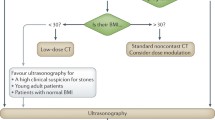Abstract
Imaging investigations play a vital role in the management of patients with kidney stones. The techniques available include plain x-ray of the abdomen, ultrasound scan, intravenous urogram, computed tomography (CT) and magnetic resonance imaging, amongst others. All of these techniques have their own individual roles to play and also have limitations. CT has been establishing itself as the imaging technique of choice and some exciting developments are on the way. However, renal stone disease is a complex condition. Furthermore, there are a variety of surgical techniques used to treat stones. It is therefore important that the strengths and weakness of each of the modalities are clearly understood and the investigations are tailored to address the problem in hand.








Similar content being viewed by others
References
Canales B, Monga M (2003) Surgical management of calyceal diverticulum. Curr Opin Urol 13:255–260
Elbahnasy AM, Shalhav AL, Hoenig DM, Elashr OM, Smith DS, McDougall EM, Clayman R (1998) Lower calyceal stone clearance after shock wave lithotripsy or ureteroscopy: the impact of lower pole radiographic anatomy. J Urol 159:676–682
Hemal AK, Goel A, Goel R (2003) Minimally invasive retroperitoneoscopic ureterolithotomy. J Urol 169:480–482
Jewett MA, Bombardier C, Caron D, Ryan MR, Gray RR, St. Louis EL, Witchell SJ, Kumra S, Psihramis KE (1992) Potential for inter-observer and intra-observer variability in x-ray review to establish stone-free rates after lithotripsy. J Urol 147:559–562
Randall A (1937) The origin and growth of renal calculi. Ann Surg 105:1009–1027
Regan F, Petronis J, Bohlman M, Rodriguez R, Moore R (1997) Perirenal MRI high signal: a new and sensitive indicator of acute ureteric obstruction. Clin Radiol 52:445–450
Stephen Amis E, Epitaph for the urogram, Radiology (1999) 213, 639–640
Sudah M, Vanninen RL, Partanen K, Kainulainen S, Malinen A, Heino A, Ala-opas M (2002) Patients with acute flank pain: comparison of MRI urography with unenhanced CT. Radiology 223:98–105
Sudah M, Vanninen R, Partanen K, Heino A, Vainio P, Ala-opas M (2001) MRI urography in evaluation of acute flank pain: T2-weighted sequences and gadolinium-enhanced three-dimensional FLASH compared with urography. AJR 176:105–112
Takebayashi S, Hosaka M, Kubota Y, Noguchi K, Fukuda M, Ishibas, Tomoda T, Matsubara S (2000) Computerised tomographic ureteroscopy for diagnosis of ureteral tumours. J Urol 163:42–46
Author information
Authors and Affiliations
Corresponding author
Rights and permissions
About this article
Cite this article
Rao, P.N. Imaging for kidney stones. World J Urol 22, 323–327 (2004). https://doi.org/10.1007/s00345-004-0413-0
Received:
Accepted:
Published:
Issue Date:
DOI: https://doi.org/10.1007/s00345-004-0413-0




